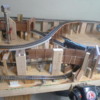Greetings Dave--
Thanks for your interest in taking the time to reply. Here is a photo of the layout, with "star" annotations. It is all one loop. The train drops down the 9-10% grade and then shoots out from the portal that's between the two purple stars in this photo. Though it cannot be discerned from the photo (this layout is only at the stage where I have applied gauze wrap) there is a depression to the "south" of the route here that will be a frozen lake. More often than not, my 681 and 682 engines end up in here after they fly off the track.
The orange star shows where I have the S-curve that causes pilot truck derailing on my 2036.
As you mentioned, I think I will attempt to put a shim underneath the homasote so as to bank the curve, but the problem is that I have 1/16" to work with at very most before the track above begins to interfere with the smokestack on the caboose...









